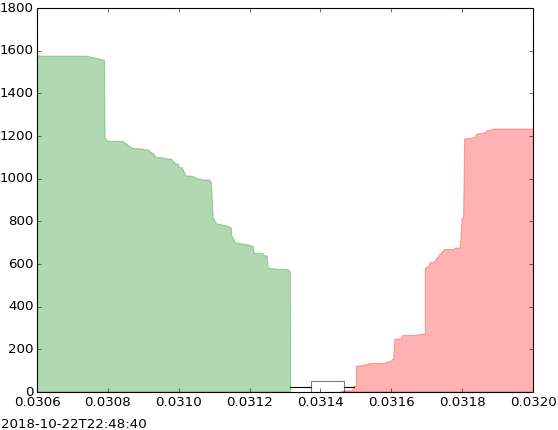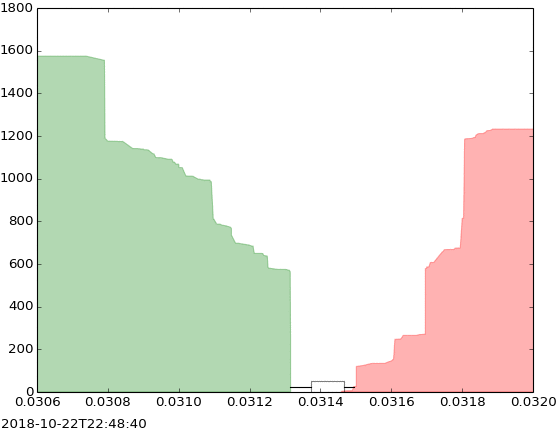From: https://medium.com/swlh/options-degenerate-marketplaces-part-1-b0ddf1c96fa6
The Toy Model
—
The original derivation for NOPE, except for my story about getting high one night and just thinking about it (which actually happened), comes from a situation I call succinctly the Toy Model.
We can imagine for simplicity a universe where all the following conditions hold true on an asset:
- There exists an asset X with spot price S which over time evolves according to a martingale-like process (this includes random walk-like processes — I am using the word like for an important reason).
- There is finite liquidity.
- For this asset, there exists a derivatives market consisting of sellers, who for the purpose of this argument are hedged.
- There exists no other asset or derivative to hedge contracts.
This roughly approximates the same assumptions used for common option pricing models such as Black-Scholes. In general, we can anticipate the spot price of an asset as a random walk. What does that mean exactly?


A random walk in the simplest form can be modeled as an infinite series of coin flips. We can divide infinite time into infinitesimal slices here. Given we start at some time t, we can represent the next time period as t+e (e being epsilon of course). For a true random walk, only the current state matters for telling us the next state (this is also called memorylessness) — no matter what I did in the previous state, my probability of (as in the above example) going up or down is still the same for each state.
This model tends to work for stock prices, especially on fairly short time ranges. Because of the churn and lack of coordination of market buyers and sellers, stock prices tend to fluctuate up and down with fairly equal probability over any given, small enough time range.
The idea of a random walk underpins most (if not all) option pricing models.
What’s more interesting, though, is when we consider the action of options on the spot price. Despite common belief (mostly from retail) the hedging of written option positions isn’t just something done by nerds and institutions with actual risk management teams (e.g. not Melvin Capital). Hedging is actual integral to the derivation of a rational price for an options contract — the price of an options contract is, at least in Black-Scholesland, equivalent to the cost of dynamically hedging a position in the underlying equivalent to the delta of the options contract continuously.
This isn’t possible in real life, but thankfully in my Toy Model I don’t actually care about real life for now.
What’s interesting about the existing of hedging and therefore the options market is unlike the assumptions made in our random walk (e.g. the memorylessness) there must exist an implicit memory-like state in our toy model. We can illustrate this with a simple example:
Suppose we have a stock X with spot price $100 at time t. For the purpose of this example, let’s define market depth as the ability to move the spot price of X by $1. In this case, let’s define a simple market depth of 50 shares — for every 50 shares transacted, we can anticipate a $1 move in the underlying (buying shares pushes the price up, selling pushes it down).
Let’s also simplify our problem by defining our random process (for each interval epsilon) as the following:
- With probability 1/2, the spot price of X should move up $1
- With probability 1/2, the spot price of X should move down $1
At time t, let’s suppose that a buyer purchases a call option at the money (so a $100 strike option representing 50 delta). At the same time this option is written, let’s assume that since the counter-party is hedged (assumption #4), they immediately purchase 50 shares to neutralize delta risk. This has, per our definition of the available market depth the immediate impact of pushing the spot price of X to $101. This in turn changes the delta of our call position to (for the purpose of the argument) 52 delta. This requires the purchase of 2 more shares to hedge accordingly, but does not move the spot price further.
More interestingly, let’s look at what happens though at time t+e:
On our 1st iteration of the random process, we run our probabilistic algorithm to determine that X’s spot price should move up $1 (1/2 chance). This means that X’s spot price is now $102. This is well within the confines of our random walk. However, we need to also adjust this to account for the open call position, which (handwaving) now has 52+x delta. This requires that the counter-party re-hedges their position accordingly, which (given the market depth of 50 shares) may or may not move the spot price.
This intuitively contradicts the idea of a memoryless process, because the buying and selling of derivatives due to delta hedging at previous times substantially impacts the movement of the underlying (as well as makes it non-linear except in the simplest examples, due to gamma hedging).
To put it even more simply, the net delta represented by the open derivatives on X represents an additive force to random changes in the underlying spot price. As we can see stepping from time t to t+e, given open call delta we can anticipate even in a random walk scenario that the spot should move in a path dependent manner given derivative positions previously opened on the asset. More interestingly, this is a generalizable effect that should exist independent of equities, for example, but in any market or market-like environment where hedged derivatives can exist.
Finally, we can see the importance of market depth here in our example. In an infinitely liquid market, the impact of hedging and re-hedging on the price would be precisely 0, since there would be ample shares to buy/sell without impacting the spot price. However in an asset with finite market depth, delta hedging and re-hedging of existing options positions has the potential to exhaust the available market depth given normal price evolution (per X’s random process).
This is where the Toy Model example ends, however, and we have to consider how assets move in real life.
The Order Book
—
In real life, we have the order book, which is a fairly comprehensive map of liquidity for a given stock at a certain time — it lists all open buy and sell orders organized by price level. It looks roughly similar to the below (where green is open bids and red is asks, Y is cumulative order depth and X is price).


On the public markets, it provides us an intuitive understanding of when and why price moves on the day to day — when asks, for instance, are exhausted (depth-wise) at a price level, the price will move up, while if bids are exhausted the price should move down. The area where the bids and asks meet is the bid-ask spread, which is roughly where the asset’s spot price is quoted at.
This means in a sense only a small fraction of the available liquidity is ever in ‘play’ at any given point (where the bid-ask meet), while generally there is substantial resting liquidity at higher and lower prices levels (this is, to my knowledge the basis of order flow trading). This provides us an understanding of how price should move according to zones of liquidity — the spot price of an asset is liquidity-seeking (it will move towards liquidity).
Market orders are liquidity consumers. Limit orders (bids and asks) can, but not always are, liquidity suppliers. A high amount of resting orders (orders away from the current bid-ask spread) tends to create a deeper market.
Order flow practitioners tend to use information about the liquidity suppliers (limit orders) to construct key levels in both directions for price movement, which tends to (at least in theory) give a trading edge. More interestingly for us is the interplay between price formation and liquidity.
Price, as I mentioned prior, is a liquidity seeking phenomenon. As the distribution of resting orders moves intraday so we expect the price of an asset to move with it. What happens, however, when liquidity thins out?
Liquidity dries up usually when one side (whether buying or selling) becomes significantly imbalanced and one-sided. This can happen, for example, when price moves up fairly rapidly above (or to the outer edges of) resting limit order, where buying pressure tapers off substantially. In this case as the flow becomes more and more imbalanced, one of two effects seems to usually occur:
- A sharp break in the direction of price momentum — This is the effect famously described by Taleb in Dynamic Hedging as a ‘liquidity black hole’ and often occurs in crash or correction type events. One-sided order flow downwards can lead to rapid selloffs.
- A reversal in price momentum — This is the most common outcome, and usually follows directly from price’s tendency to seek liquidity. As it becomes overstretched above existing zones of liquidity, it tends to bounce off and seek existing liquidity downwards/upwards.
So what does this lecture on the order book have to do with options?
The Net Options Pricing Effect and Liquidity
Let’s finally look at what happens when you consider the effect implied by the Toy Model example and the real life order book. Given a net delta in the options market for an underlying (e.g. the put and call delta implied by the options market together is not zero), we anticipate it puts pressure on the available market depth as price evolves intraday. This happens in two related but separate ways:
- Gamma rehedging — This effect is especially noticeable for highly volatile securities. Gamma rehedging of existing positions weighs non-linearly on the available market depth as the asset spot price moves up, provoking some rather dramatic effects at times.
- Delta hedging and rehedging — This tends to be a dominant effect (compared to gamma rehedging) on less volatile tickers (for instance, SPY). For SPY for example, given available data (e.g. the Pearson correlation of the Squeezemetrics’ GEX versus NOPE), there seems to be a strong relationship between gamma exposure for day t+1 and the delta of calls traded for day t. This implies at least naively that much of SPY’s open interest has rapid turnover and that the delta hedging of newly written positions may strongly impact SPY intraday price formation.
The impact of option contract delta hedging on the price of the underlying is, to use a Lily-ism, a measure of options dominance. In a highly options dominant environment, we anticipate that with fairly small changes in the underlying’s price, the necessary hedging required to neutralize delta exposure for counter-parties should exhaust significant market depth. This, at extreme levels, should not only potentially provoke acceleration of price momentum in the direction of the delta skew (as illustrated in our Toy Model), but also potentially cause it to reverse once available liquidity is exhausted. Conversely, in a low options dominance environment, we do not anticipate this effect to be significant.
Conclusion
You should be proud if you’ve read this far. Not only is this fairly dense and theoretical, but I also wrote it at midnight and didn’t put it through spell check.
That said, let’s do a quick recap:
- Due to the impact of delta hedging and rehedging, we can view an asset with a derivatives market as not obeying a true random walk.
- Liquidity is a strong determinant of intraday price, and it is modeled by the order book.
- When market depth is exhausted at a given price level, price tends to be liquidity seeking, and will move to the zone of highest liquidity.
- When price moves directionally far enough to a zone of low liquidity, it tends to move sharply or reverse.
- Given an options dominant state (where the delta implied by the open options contracts is a large fraction of the underlying asset’s liquidity), we anticipate quicker exhaustion of market depth for even small changes in the asset price.
In the next part I will formalize the reversion hypothesis and discuss the role of implied leverage in both abating and creating volatility.